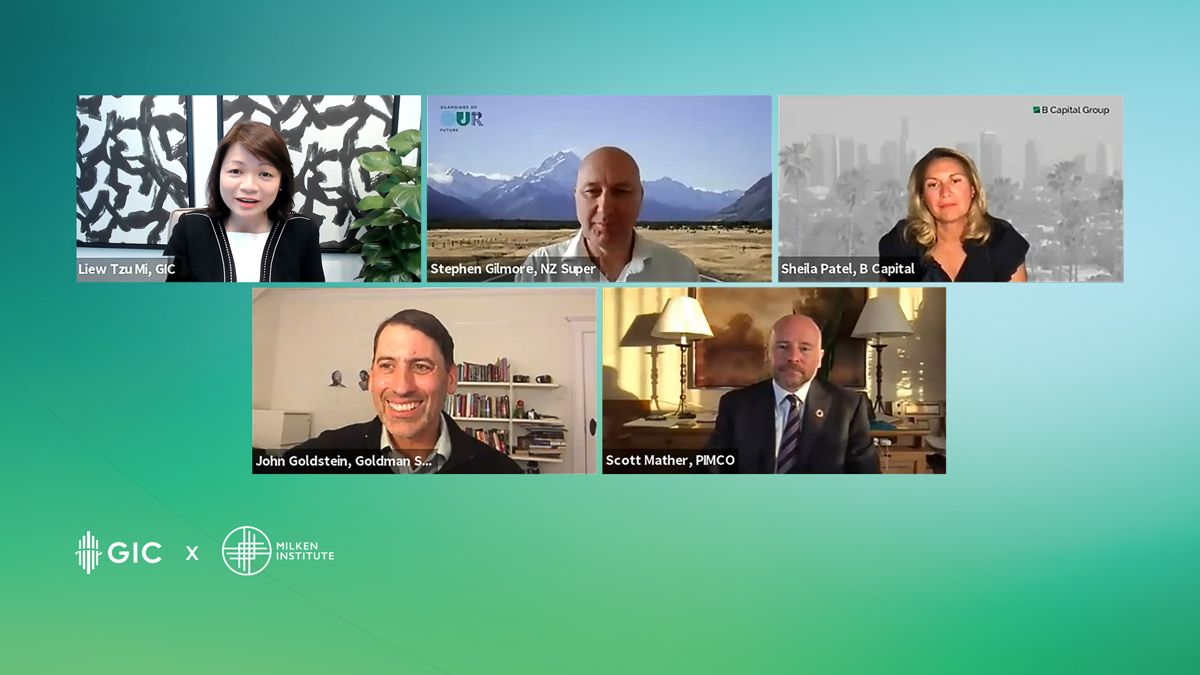This article summarises the key takeaways from a webinar co-hosted by GIC with the Milken Institute on integrating ESG into investment and risk management.
Liew Tzu Mi, CIO, Fixed Income and Chair of the Sustainability Committee at GIC participated in a panel with Stephen Gilmore, CIO at New Zealand Super Fund, John Goldstein, Chair of the Sustainable Finance Group at Goldman Sachs, Scott Mather, CIO, U.S. Core Strategies at PIMCO, and Sheila Patel, Vice Chairman at B Capital Group.
They discussed their experiences in sustainable investing, key challenges faced and emerging trends. Please see below for the recording of their conversation and a summary of the key insights shared.
Sustainable investing in practice
- Sustainable investing has graduated from a specialist discipline to becoming a core driver of the economy and financial markets.
- Sustainability shouldn’t be restricted to thematic investing only but must be fully integrated across the entire portfolio, which requires continuous education, engagement and a mindset shift across the entire organization.
- Investors should not adopt a one-size-fits-all approach to ESG. They should account for the differences across regions, countries, sectors and industries, as they support their portfolio companies on their transition journey.
- Sustainable investing is also about opportunities to transition from brown to green, which creates value for companies and their stakeholders, and ultimately drives better ESG outcomes for the broader economy.
- There has been a proliferation of ESG solutions with varied levels of sustainability integration. Investors must do their due diligence to choose products that deliver both risk-adjusted returns as well as optimal results with regards to ESG, and should look at both active and passive strategies.
Key challenges
- In the pursuit of ESG goals, we need to avoid unintended consequences. In emerging markets, we often see an inherent conflict between the ‘S’ and ‘E’ in ESG, as countries balance the adoption of more sustainable practices with socio-economic development for their populations. We need to consider local conditions and needs, and how we can support their transition journey.
- Investors are increasingly looking for forward-looking frameworks and performance data to support ESG integration and quantification, and to acquire a holistic view of how their overall portfolio is positioned with respect to their sustainability goals. It’s no longer about “do you have a policy” but “how do you perform”.
- We have to deal with risk factors that were not material 10 years ago but have become material now, such as the physical impact of climate change. Because of the accelerating need to incorporate ESG issues into portfolios, more needs to be done to improve data quality and standards, ESG integration, as well as portfolio construction and management tools.
Five steps to get started in sustainable investing
- (1) Clear any preconceptions or bias associated with ESG to make way for objective economic analysis; (2) ground your efforts in a robust sustainability thesis; (3) develop dedicated support and expertise without overwhelming people or creating silos; (4) find an entry point; and (5) remember that this is a process and not a single act.
Emerging trends
- In the fixed income space, we are seeing rapid growth and innovation in sustainability-linked instruments. Opportunities to invest in different types of products, focusing on certain sectors or niches, will emerge, such as solar or electric car ABS.
- The social element of ESG is coming to the forefront. According to MSCI data, in 2020, social bonds accounted for 29% of all global sustainability bond issuance compared to only 5% in 2019.







